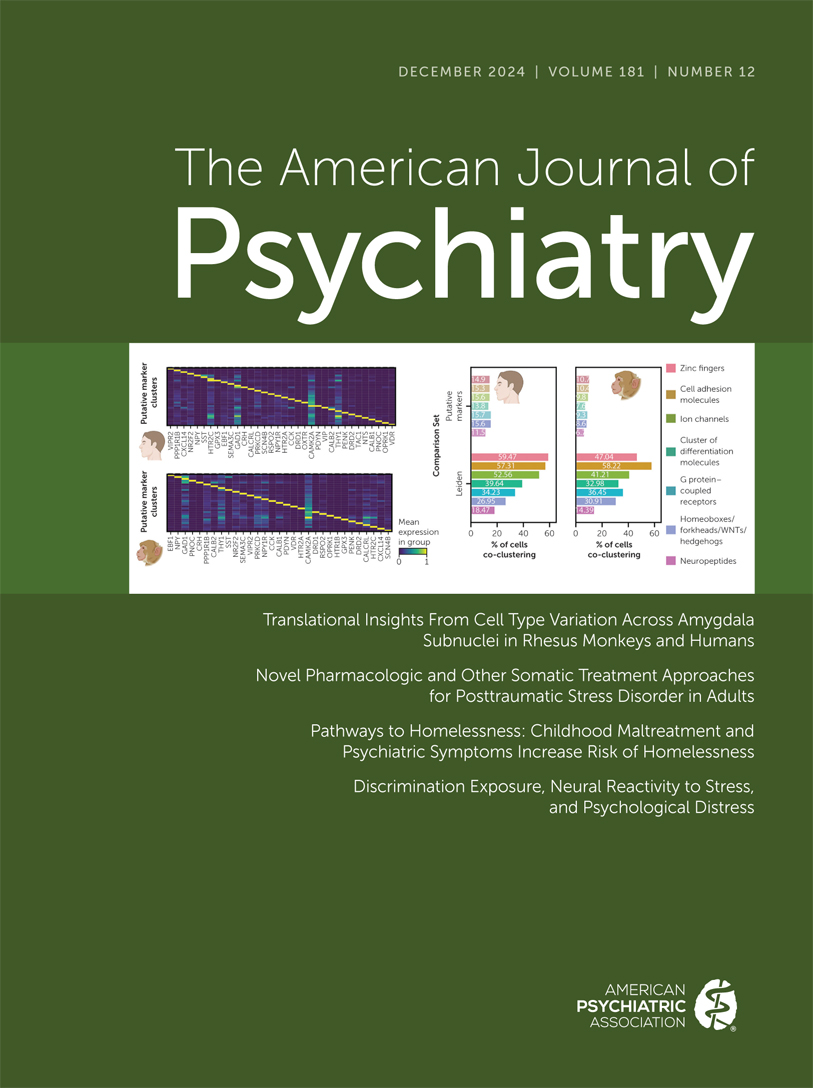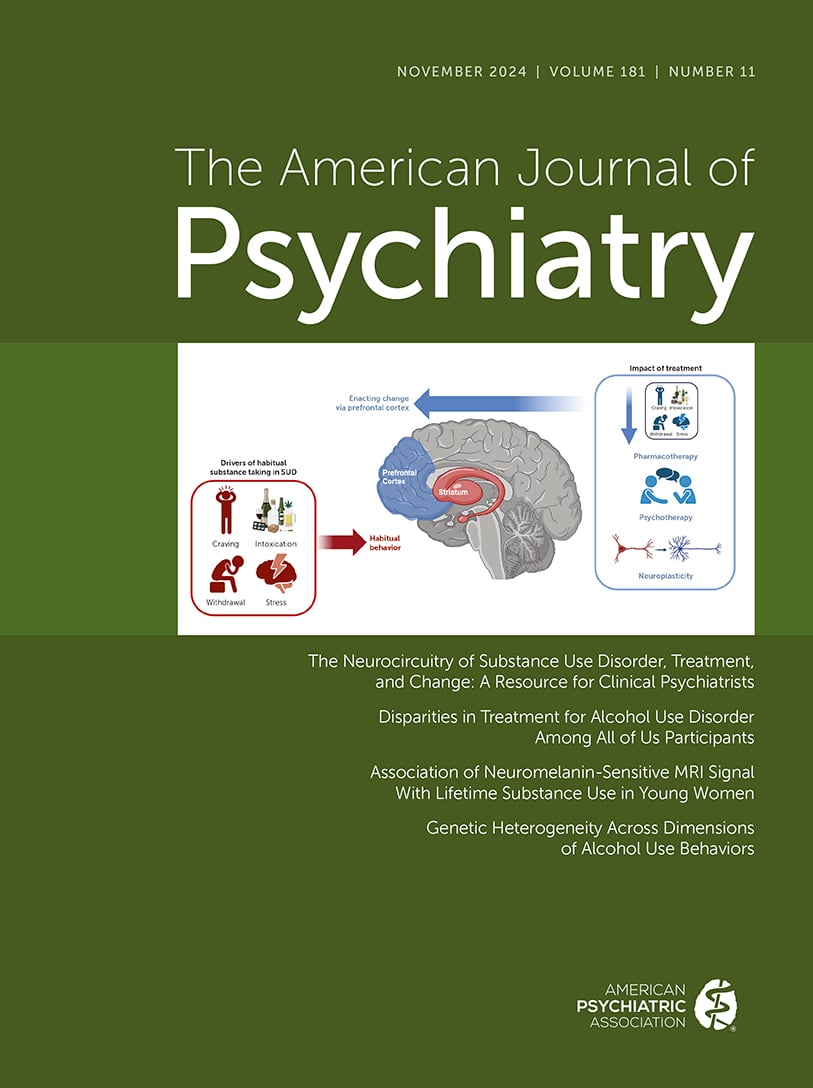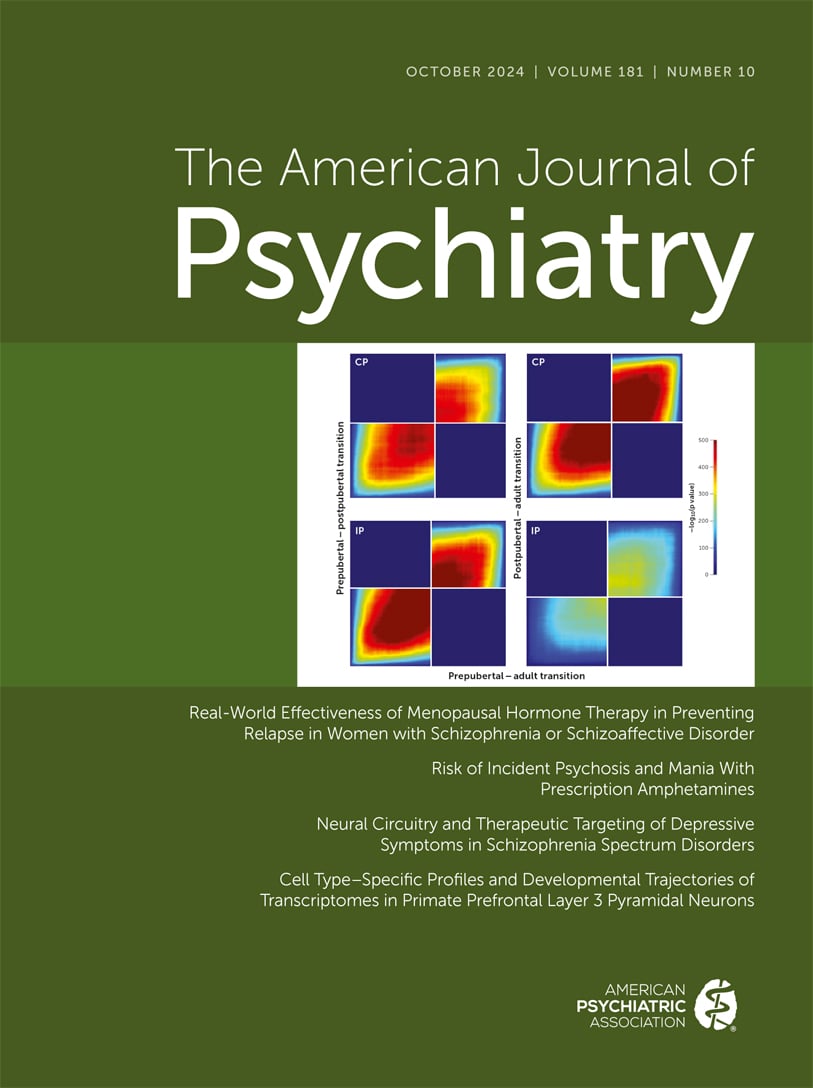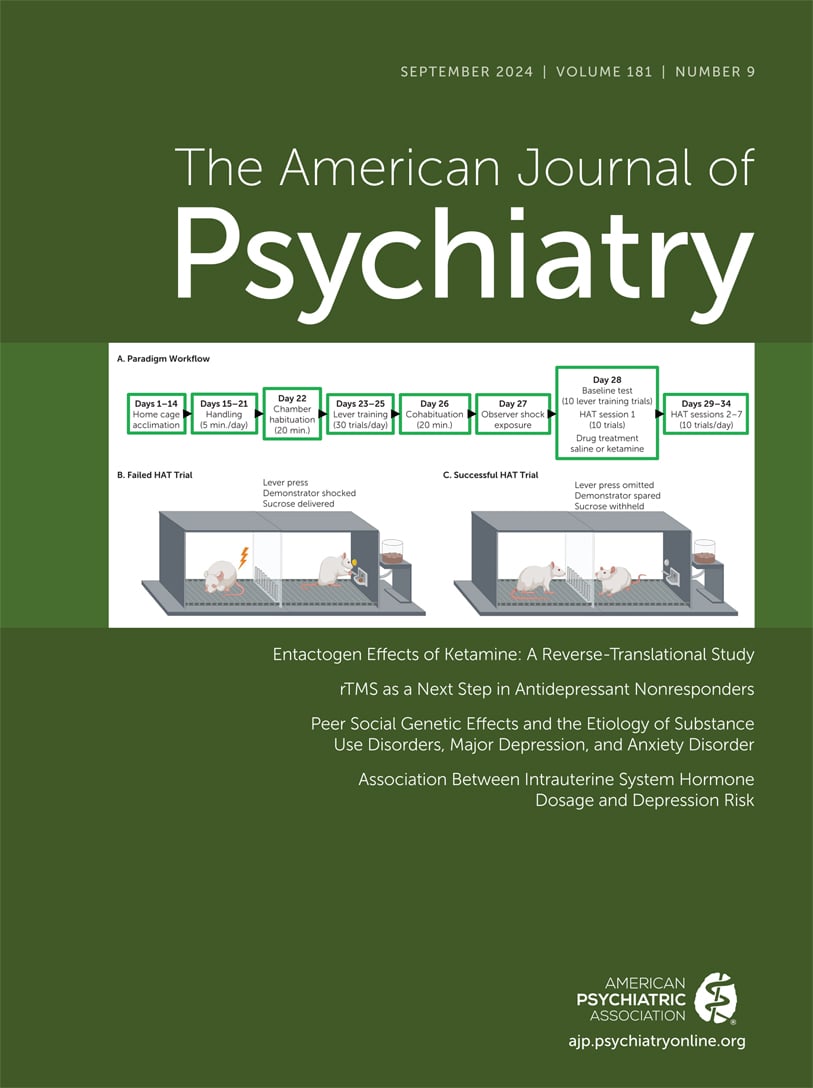American Journal of Psychiatry
- Volume 159
- Number 6
- June 2002
Editorial
Reviews and Overviews
Publication date: 01 June 2002
Pages895–908OBJECTIVE: Genetic and neurofunctional research in autism has highlighted the need for improved characterization of the core social disorder defining the broad spectrum of syndrome manifestations. METHOD: This article reviews the advantages and ...
https://doi.org/10.1176/appi.ajp.159.6.895Publication date: 01 June 2002
Pages909–916OBJECTIVE: This study examined rates of contact with primary care and mental health care professionals by individuals before they died by suicide. METHOD: The authors reviewed 40 studies for which there was information available on rates of health care ...
https://doi.org/10.1176/appi.ajp.159.6.909Images in Neuroscience
Clinical Case Conference
Images in Psychiatry
Article
Publication date: 01 June 2002
Pages927–933OBJECTIVE: Longitudinal outcomes of bipolar disorder with onset in the late teenage years or in adulthood have been reported, but little is known about the natural history of childhood-onset mania. This study sought to provide rates and predictors of ...
https://doi.org/10.1176/appi.ajp.159.6.927Publication date: 01 June 2002
Pages934–940OBJECTIVE: The study investigated the hypothesis that EEG asymmetry scores (indicating higher right and lower left frontal brain activity) are associated with vulnerability to negative mood states and depressive disorders. Gender and clinical history ...
https://doi.org/10.1176/appi.ajp.159.6.934Publication date: 01 June 2002
Pages941–946OBJECTIVE: Each year approximately 2.5 million Americans are hospitalized after sustaining traumatic physical injuries. Few investigations have comprehensively screened for posttraumatic symptomatic distress or identified predictors of posttraumatic ...
https://doi.org/10.1176/appi.ajp.159.6.941Publication date: 01 June 2002
Pages947–953OBJECTIVE: Although the association between depression and smoking has been consistently established, little evidence regarding the mechanisms that influence this association is currently available. The present study evaluates alternate familial ...
https://doi.org/10.1176/appi.ajp.159.6.947Publication date: 01 June 2002
Pages954–960OBJECTIVE: The authors sought to increase understanding of the brain mechanisms involved in cigarette addiction by identifying neural substrates modulated by visual smoking cues in nicotine-deprived smokers. METHOD: Event-related functional magnetic ...
https://doi.org/10.1176/appi.ajp.159.6.954Publication date: 01 June 2002
Pages961–967OBJECTIVE: Although the brain areas involved in emotional response and in the recognition of others’ emotions have been reported, the neural bases of individual differences in affective style remain to be elucidated. Alexithymia, i.e., impairment of the ...
https://doi.org/10.1176/appi.ajp.159.6.961Publication date: 01 June 2002
Pages968–974OBJECTIVE: There are no factor analytic studies specifically including symptoms representative of depressive inhibition among manic patients, although Kraepelin described several mixed affective states with depressive inhibition. There is controversy as ...
https://doi.org/10.1176/appi.ajp.159.6.968Publication date: 01 June 2002
Pages975–982OBJECTIVE: The authors compared sustained attention deficits measured by the Continuous Performance Test in patients with various affective disorders and patients with schizophrenia and examined whether Continuous Performance Test deficits in patients ...
https://doi.org/10.1176/appi.ajp.159.6.975Publication date: 01 June 2002
Pages983–990OBJECTIVE: This multicenter study aimed to verify whether the historical and psychopathological characteristics of a large group of patients with deficit schizophrenia were consistent with those reported in previous studies. The authors also tested the ...
https://doi.org/10.1176/appi.ajp.159.6.983Publication date: 01 June 2002
Pages991–997OBJECTIVE: This study determined the general fertility rate and age-specific fertility rates for women with psychotic disorders. METHOD: This historical matched-cohort study of patient records from a primary care database (the General Practice Research ...
https://doi.org/10.1176/appi.ajp.159.6.991Publication date: 01 June 2002
Pages998–1004OBJECTIVE: Competing-risks analysis was used to determine the 1-year longitudinal outcomes, including mortality, associated with multiple idiopathic physical symptoms in a population sample. METHOD: The authors analyzed baseline and 1-year follow-up data ...
https://doi.org/10.1176/appi.ajp.159.6.998Publication date: 01 June 2002
Pages1005–1010OBJECTIVE: This study examined recent changes in the prescribing patterns for medications to treat bipolar disorder in office-based psychiatric practice. METHOD: The authors analyzed physician-reported data from the National Ambulatory Medical Care Survey ...
https://doi.org/10.1176/appi.ajp.159.6.1005Publication date: 01 June 2002
Pages1011–1017OBJECTIVE: The effects of olanzapine and divalproex for the treatment of mania were compared in a large randomized clinical trial. METHOD: A 3-week, randomized, double-blind trial compared flexibly dosed olanzapine (5–20 mg/day) to divalproex (500–2500 mg/...
https://doi.org/10.1176/appi.ajp.159.6.1011Publication date: 01 June 2002
Pages1018–1028OBJECTIVE: Newer antipsychotic drugs have shown promise in ameliorating neurocognitive deficits in patients with schizophrenia, but few studies have compared newer antipsychotic drugs with both clozapine and conventional agents, particularly in patients ...
https://doi.org/10.1176/appi.ajp.159.6.1018Publication date: 01 June 2002
Pages1029–1034OBJECTIVE: Abnormalities in the immune system in schizophrenia have been described. However, important findings such as high levels of activating cytokines in the CSF and signs of CNS inflammation have been controversial. The authors conducted a trial of ...
https://doi.org/10.1176/appi.ajp.159.6.1029Publication date: 01 June 2002
Pages1035–1043OBJECTIVE: Adjunctive pharmacological agents are extensively used in the treatment of patients with schizophrenia. This cross-sectional study examined the prevalence of the use of adjunctive agents, the extent to which their use conforms with ...
https://doi.org/10.1176/appi.ajp.159.6.1035Brief Report
Publication date: 01 June 2002
Pages1044–1046OBJECTIVE: Neurodevelopmental impairments have been associated with early-onset schizophrenia, early-onset bipolar disorder, and childhood-onset affective disorder. The authors investigated whether delayed childhood motor skills predicted persistent ...
https://doi.org/10.1176/appi.ajp.159.6.1044Publication date: 01 June 2002
Pages1046–1048OBJECTIVE: Attention deficit hyperactivity disorder (ADHD) has been shown to be highly heritable, and recent molecular genetics studies have focused on candidate genes in the dopaminergic and noradrenergic systems. One recent study reported an association ...
https://doi.org/10.1176/appi.ajp.159.6.1046Publication date: 01 June 2002
Pages1048–1050OBJECTIVE: Menstrual dysfunction occurs frequently in patients with bulimia nervosa. Whether this is associated with diminished fertility is unknown. This study examined menstrual and reproductive function in bulimia nervosa patients retrospectively, with ...
https://doi.org/10.1176/appi.ajp.159.6.1048Publication date: 01 June 2002
Pages1051–1052OBJECTIVE: Using data from the Epidemiologic Catchment Area (ECA) study, the author attempted to replicate the finding of the National Comorbidity Survey that the prevalence of depression associated with somatic symptoms was much higher among women than ...
https://doi.org/10.1176/appi.ajp.159.6.1051Publication date: 01 June 2002
Pages1053–1055OBJECTIVE: The authors examined an index of dopaminergic neurotransmission in recently abstinent cocaine-dependent patients. METHOD: CSF concentrations of the dopamine metabolite homovanillic acid (HVA) were determined in 30 recently abstinent cocaine-...
https://doi.org/10.1176/appi.ajp.159.6.1053Publication date: 01 June 2002
Pages1055–1057OBJECTIVE: The authors studied weight gain mechanisms and energy balance in patients treated with olanzapine. METHOD: The body mass index of male schizophrenic adolescent inpatients treated with olanzapine (N=10) and of 10 matched patients treated with ...
https://doi.org/10.1176/appi.ajp.159.6.1055Publication date: 01 June 2002
Pages1058–1060OBJECTIVE: Since olanzapine-induced weight gain may be attributable to the antagonistic activity of olanzapine at the serotonin-2C receptor, the authors hypothesized that it might be attenuated by addition of the selective serotonin reuptake inhibitor ...
https://doi.org/10.1176/appi.ajp.159.6.1058Letter to the Editor
Book Forum: Diagnosis and Treatment
Book Forum: Child/Adolescent Psychiatry
Book Forum: Religion and Philosophy
Correction
Past Issues
View Issues Archive
Vol. 181 | No. 12

Vol. 181 | No. 11

Vol. 181 | No. 10
